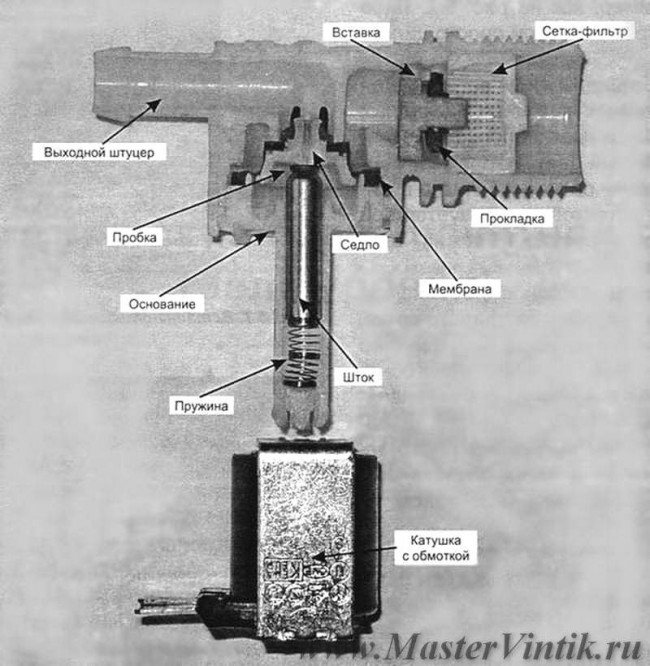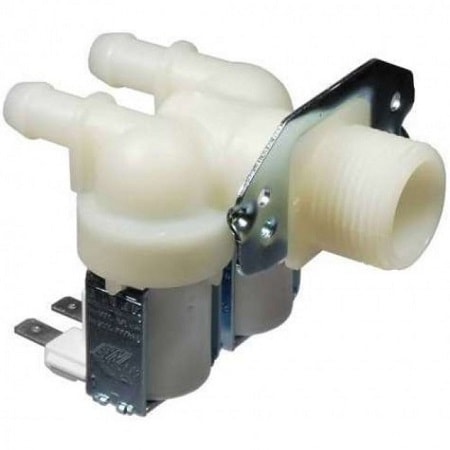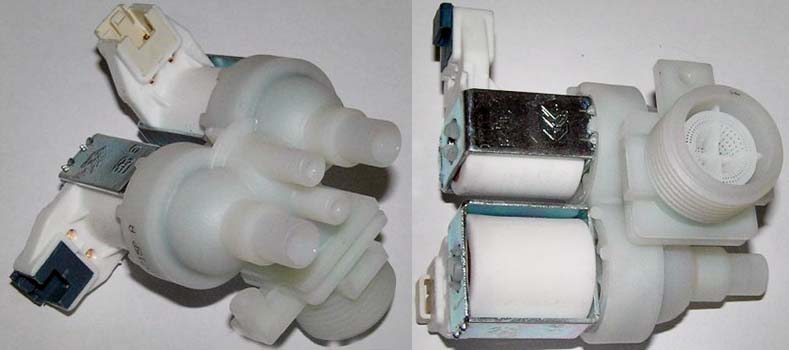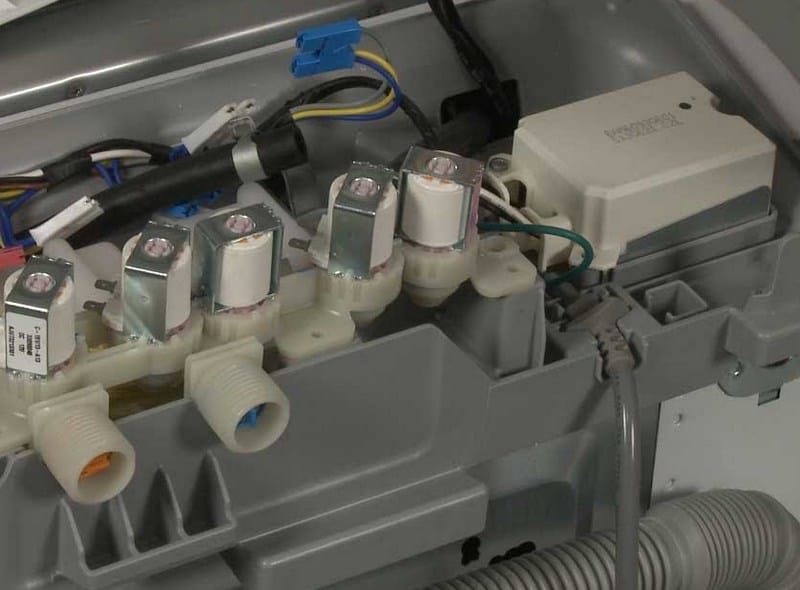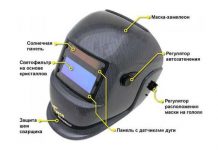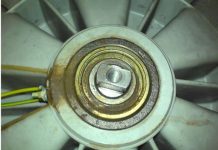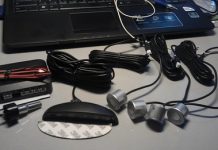In detail: do-it-yourself repair of a washing machine solenoid valve from a real master for the site my.housecope.com.
 Alteration of the valve from the washing machine to power supply with a voltage of 12 volts DC
Alteration of the valve from the washing machine to power supply with a voltage of 12 volts DC
Electrical valves are required to automatically control various hydraulic systems. Finished products are quite expensive. Let's look for a cheaper solution.
The most accessible valves are from out-of-order washing machines.
The coils of such devices are rated for 220 volts AC, which limits their capabilities. Sometimes it is more convenient to operate the valve with a low voltage of 12 volts.
I needed such a device to regulate the heater mode of the interior of a VAZ car. Suitable valves from foreign cars are outrageously expensive, and with a rise in the exchange rate, they become a luxury item. Let's try to remake the electric valve from the washing machine to the on-board voltage of the car.
First, let's see how everything works.
We remove the coil by inserting a thin screwdriver into the gap between the solenoid and the body. In this case, you can slightly squeeze the petals that secure the solenoid coil with pliers.
Further, if there is a choice, choose from several valves with a minimum blowdown resistance. Air movement - from the threaded inlet. We open the valve with a magnet, for example from a speaker.
We disassemble the selected valve further - we take out the filter mesh with pliers, a rubber washer with a screwdriver - a gasket (fluid flow regulator) and a wire hook for the regulator insert.
To operate at a voltage of 12 volts, it is necessary to replace the solenoid (coil) of the valve.
The most suitable solenoid was found in the EPHKH air valve of the VAZ 2105.
Since no images of the entrails have been found on the Internet, I will give them for the curious.
The simplest thing is to cut off the rolling on emery or cut it off with a file along the outer edge.
Valve cover (view from the inside):
| Video (click to play). |
Stock, it is a cork. The air flow is blocked with a rubber insert at the end. On the opposite end there is a depression for the spring:
Steel washer for closing the magnetic flux and a non-magnetic guide in which the rod moves:
Oval O-rings seal the leads from the inside of the housing. We'll need one of them later, so save them.
And finally, the case from the inside. The end face of a stationary magnetic circuit with a projection for a spring is visible:
Next, we are finalizing the body. On emery we grind a tube with a rivet from the back, and putting the body upside down, carefully knock out the remnants of the internal magnetic circuit with a beard. If the body is washed inwards, we eliminate the deformation. Next, drill the central hole to a diameter of 9mm.
To create a magnetic system similar to the valve system from a washing machine, it is necessary to cut two strips from tin from a tin can - one 15 mm wide, the other 10 mm. The length of the strips should be such that a ring of about 1.5 turns is wound on the valve stem body from the washing machine.
On the stem body we put on a steel washer from the EPHH valve, then a 15mm tin ring (it should pass freely through the washer), then one of the oval rings from the leads, then a coil (put on with little friction), then a steel body from the EPHH valve.
After that, in the gap between the stem body and the valve body, we evenly settle the second tin ring, 10mm wide.If the operation is difficult, you can shorten the length of the strip so that a little more than 1 turn is wound, with an overlap of 2-3 mm.
When the remaining part is 0.5 - 1 mm, the edges of the tin ring are bent outward with a thin screwdriver or knife.
In the frontal part of the solenoid, the edges are also slightly grooved.
The assembled valve is triggered in the position with the leads down at a voltage of 10-11 volts.
In any model of washing machine, the most important element is the inlet valve for the washing machine, sometimes referred to as the filler valve. In this article we will tell you how this structural element is arranged, describe the principle of operation, and what types exist.
Washing machine inlet valve, has two types of working state - open and closed. In the second state, it arrives most of the time. A coil is installed inside the valve, to which the program supplies an electric current, which is a signal to open the valve, which accordingly leads to the filling of the working space of the machine with water. This principle of operation gave rise to another name for the valve - electromagnetic.
When the tank is filled to the required level, the control program sends a second signal to the filling valve, after which it closes and the liquid stops flowing into the system.
In almost all models of washing machines, the valve is located at the top of the structure, near the back wall. But in those machines where the laundry is loaded vertically, the valve is located at the bottom of the unit, also near the back wall. In the first case, in order to get to the element we need, it is necessary to remove the back cover, and in the second case, the side panel is dismantled.
Today inlet valve for washing machine has a more complex design, where the internal device is divided into many sections, and each of them has its own electromagnet. Accordingly, each section is connected to a specific place where water is required, and as needed, the control program sends signals and activates the coils. Therefore, we can safely distinguish the following types:
- single coil valves;
- with two coils;
- with three coils.
Also, now all coils have a completely electrical structure, they completely lack mechanical components.
To determine the serviceability of the valve, it must be removed. After that, connect the water supply hose to it, and supply current to the coils. If the unit is in good working order, the valve will open and let water through. After stopping the voltage supply to the coil, the locking mechanism should close. This check is very easy and will not cause any particular difficulties, but it must be carried out carefully, since you work in high humidity conditions with an electrical appliance, in no case do not allow exposed wires to come into contact with liquid.
Also, it is necessary to check the following units of the unit:
- It is necessary to check the filter mesh on the valve and clean it of any dirt.
- If the valve does not open, you should check if the solenoid coil in it is burned out, for this use a multimeter. The resistance of the working coil ranges from 2 to 4 ohms.
- Check for the presence of plastic elements in the valve fittings, they are designed to contain the water pressure.If these inserts are not available, then this structural element must be replaced.
The inlet valve of the washing machine is a non-separable part, therefore it cannot be repaired. This operation, for replacement, is carried out as follows:
- Firstly, it is necessary to de-energize the washing machine, then turn off the water supply and dismantle the back cover.
- We disconnect all hoses from the valve, the main thing is to remember which one, where it was installed.
- Then unscrew all the fasteners holding our part.
- Dismantle the old valve.
- Next, install a new element, and in the reverse order, assemble the washing machine.
After completing all the necessary points, check the performance of your unit, whether water is supplied and whether everything is functioning correctly.
The inlet (inlet) valve is required in the washing machine to dispense water into the tank at a certain time. To check the inlet valve of the washing machine, we will briefly describe how it works.
The valve is normally closed. When voltage is applied to the valve coil, an electromagnetic field is created, which acts on the magnetic rod and draws it into the coil, the membrane opens and passes water into the valve outlet and further into the dispenser hopper and the washing machine tank. After water is collected in the tank, the power to the coil is turned off, the membrane returns to its original position and blocks the access of water.
There are valves with one, two and three coils. The number of coils, and, accordingly, water supply channels, depends on the design features of specific models.
Where a single-section water supply valve is used, the further distribution of the flow is controlled by the mechanical lever of the command device, directing the stream into one or another section of the dispenser. Thus, the single-section valve is clearly only used in conjunction with a command device, that is, in earlier models.
In models where all processes are controlled by an electronic module, and there is no mechanical drive, two and three-section intake valves are used. But here you can ask a reasonable question: how can a two-piece valve ensure the intake of detergent in three sections of the dispenser? The answer is this: one of the sections is provided by the flow of water, which is created when both coils are turned on, then their flows are connected and form a third new direction.
To check the inlet valve, it is advisable to remove it from the washing machine, connect it to the inlet hose and alternately apply 220 V to each coil. A serviceable valve should open, and after disconnecting from the power supply, close tightly. The stream of water must be directed into a container with water.
- First of all, you need to check the valve mesh, if it is clogged, then water will not flow into the valve. The mesh must be removed, cleaned and reinserted. With this malfunction, the washing machine will fill in water very slowly, or it will not fill at all.
- If the valve does not open, then the coil is most likely burnt out. You can check it by measuring the resistance, which should be 2-4 kOhm. A defective coil can be replaced by removing it from a different valve. In this case, in one of the washing modes, water will not be supplied to the machine.
- If the valve opens, but after turning off the power, water continues to ooze for some time, then its membrane has lost its flexibility or the stem spring has weakened. Such a valve must be replaced, because, once installed again, it will constantly let water through, which can lead to flooding of the apartment.
- Also, you need to check the presence of pressed, plastic inserts in the fittings. These inserts reduce the flow of water per unit of time. They are mainly used on the valve connection that supplies water to the rinse aid compartment. When the insert falls out, the amount of water that the valve passes through increases, and it overflows the corresponding compartment in the corresponding wash cycle.This valve must also be replaced.
Basically, the inlet valves of front washing machines are located at the back of the top cover. The top cover must be removed to gain access.
The valves of vertical machines are often located on the back wall at the bottom, in the basement area. To gain access, in most cases, it is necessary to separate the side wall.
To replace the inlet valve, you must:
- turn off the water tap and disconnect the inlet hose from the washing machine;
- get access to the inlet valve;
- disconnect the electrical wires;
- disconnect the hoses from the valve fittings (in this case, disposable clamps can be replaced with worm gear, reusable);
- unscrew the screws securing the valve to the body of the washing machine (some valves, especially on German cars, are attached to the body with a latch, and to remove such a valve, you need to carefully remove the latch tongue, turn the valve body to the required position and remove it).
The installation of a new spare part is carried out in the reverse order.
Service center "RemBytTech" provides services for the repair or replacement of the inlet valve of the washing machine at home in Moscow and the Moscow region.
- will arrive within 24 hours after the call with all the necessary tools and spare parts specifically for your washing machine;
- will repair or replace the part within 30-60 minutes right at your home;
- will issue a receipt with up to 6 months warranty for the work done and the installed parts.
- in the blockage of the inlet filter-mesh of the valve;
- in a blockage, lime or rusty deposit on the internal components of the valve: the stem wedges due to rust, the diaphragm does not open, the stem spring has lost its elasticity, etc. (only for gasketed valves).
In other cases, the node is changed to a new one.
- to replace the intake valve - from 1500 rub.
- for repair - from 1000 rub.
Components required for repair or a new part are paid additionally. Or the technician installs a valve purchased by the customer. The exact cost is calculated by a specialist after diagnostics and depends on the brand, model and type of machine (with horizontal or top loading).
Here is an approximate price list for repair and replacement of the inlet valve, depending on the brand of washing machine.
*Attention! The price does not include the cost of a new part or components. If the master installs a new valve from his stock, then he is paid additionally.
The cost of the replacement service includes:
- disassembly of the machine;
- dismantling the old valve;
- installation of a new part;
- checking valve operation;
- assembly of the AGR.
There are two ways to order repairs. By phone
from 8.00 to 22.00 daily. Or via an online application - at any time.
When calling a specialist, you must inform:
- Make and, if possible, model of your washing machine. For example, Bosch Maxx 4 or Indesit Wiun 102. Look for the model name on a sticker on the body of the washing machine, usually on the back. The information is needed so that the technician can take with him a new valve suitable for your AGR. If you have already bought it yourself, then just indicate the brand.
- Convenient repair time.
- Your address, name and telephone number.
The master will call you in the morning on the appointed day to confirm the time of arrival.
- Free consultation. Ask any questions about the operation or repair of washing machines in the comments to the article or in the Question-Answer section. The master will respond in 48 hours. Prefer to communicate by phone? Then leave a request for repair to dispatchers or online. A specialist will call you and advise on the possible financial costs of repairs. Please note that we do not give telephone consultations on issues of self-repair.
- Departure and diagnostics - as a gift! Only work on repair / replacement of the water supply valve and new parts are paid for.
- Home repair within 24 hours after calling the master. 84 specialists of "RemBytTech" are dispersed throughout Moscow and the Moscow region. The foreman leaves the nearest branch, so we carry out the repairs as quickly as possible. Can you accept a master only on a certain day? No problem - indicate this in your request, we will arrive at the appointed time.
- Daily schedule from 8 am to 10 pm. We repair washing machines every day, seven days a week, from early morning to late evening. It will not be difficult for even the busiest to find a convenient repair time, for example, on a weekend.
- 6 months warranty. To work and a new valve. If the part is purchased by the customer, then the warranty only applies to the installation.
- Job discounts up to 10%. We give discounts for work to pensioners and low-income citizens. To receive a discount, you must present a document (pension certificate, Muscovite social card, etc.).
Filling valve of washing machines or KEN (stands for Valve Solenoid Filling) is a membrane in the housing, which, upon a signal from the control module, opens, and water enters the machine under the pressure of the water supply. The diaphragm mechanism is driven by the solenoid coil of the valve.
On modern washing machines, the part usually consists of two valves. The first is responsible for the collection of water during the wash cycle, the second for rinsing. There are also KENs with 3 sections (prewash, wash, rinse). In the "ancient" models of the CMA, the valve is usually single.
85% of KEN breakdowns are "to blame" electromagnetic coil... Its winding burns out, the membrane does not open when water is poured at the command of the control unit, and the washing machine does not pick up.
Attention! Operating a washing machine with a faulty water valve coil is fraught with failure of the control board, and, as a result, more expensive repairs. Therefore, we do not recommend using the machine in this case, even if it partially collects water, but we advise you to immediately call the master.
More rarely, service engineers of "RemBytTech" are faced with the following malfunctions of the water supply valve, mainly in machines with a long service life.
- Clogged strainer at the inlet of KEN. A filter is installed in front of the valve and protects it from particles contained in the tap water. During use, the filter gradually becomes clogged, which makes it difficult for water to flow. The washing machine starts to draw water slowly and may give a water fill error.
- Diaphragm damage. It happens due to wear and tear, but most often, this "suffers" machines that are operated or stored in unheated rooms. When the remaining moisture in the valve freezes, not only the membrane breaks, but sometimes the valve body itself also cracks. A KEN with a damaged membrane will allow water to pass through, so the CM will collect even in the off state.
- Clogging, rust and limescale deposits on the parts of the valve in contact with water. They can both interfere with the collection of water by the machine, and, conversely, lead to a situation when the CMA fills with water in the off state. First of all, the membrane and its mechanism are vulnerable - an elastic band, a plastic part, a spring, a stem. For example, when the stem wedges in the closed position due to rust, the diaphragm does not open and water does not enter the machine.
The unit is rarely repaired for the following reasons:
- Non-separable design. KEN does not understand most modern washing machines. Manufacturers consider it a consumable and, in the event of a malfunction, they advise to change it completely.
- No parts available. In older CMA models, inlet valves are usually collapsible, but components for them are not sold (diaphragms, coils, rods, etc.). They can only be found on the analysis of old washing machines.
Therefore, the "RemBytTech" masters perform only the following repair work:
- cleaning the inlet valve strainer (this is easy to do on your own);
- cleaning the valve itself, if it is collapsible and the malfunction is associated with blockage, lime or rusty deposits on the internal components of the part.
Other types of repairs are either physically impossible or economically impractical.
A breakdown of the water supply valve is always accompanied by one of the following symptoms, and in the first three signs, a water filling error may also be issued.
- Gets poorly. Can signal a clogged inlet filter in the inlet valve.
- No water comes in at all. Perhaps the coil has burned out, the strainer or the valve itself is clogged, the valve stem is jammed.
- It fills in water for washing, but not for rinsing, or vice versa. The coil of that section of the valve, which is responsible for the set on the corresponding cycle (for double or triple valves), has burned out.
- It collects water itself in the off state or fills and drains during washing. Damaged valve diaphragm or stem jammed open.
Note!In addition to valve failure, the presented symptoms can signal other malfunctions. For an accurate "diagnosis", an examination of the MCA by a specialist is required.
Contact the professionals at the RemBytTech service if you suspect that the bay valve in your washing machine is out of order. We will check and, if necessary, repair or replace the faulty part with a new one. Our phones:
As a standard, the master arrives during the day at a time convenient for you or on the day specified when contacting.
Solenoid valves for connecting various devices to water supply systems are used quite often. Such devices have an electromechanical principle of operation and are a type of locking equipment. Experts call them solenoid (solenoid - magnet).
Solenoid shut-off elements are often found in various industries, in water and gas supply systems. In accordance with its functions, in washing machines, this device is called a filling or inlet valve.
All washing machines, such as Indesit, Samsung, Ariston, Zanuzzi and other models, must be equipped with a solenoid valve.
This device has two working states: open and closed. As soon as the washing program is selected, the mechanism of the electromagnetic device will work and open, after which water will begin to flow. The volume of water is controlled by an electronic module, which in turn controls the operation of the pressure switch and the inlet solenoid valve. The filling device is triggered by supplying power from the control unit to the coil of this device.
The water supply valve for the washing machine acts as a shut-off valve, in fact, a tap that opens and closes the flow of water into the washing tank through a container with detergents at the right time, according to the washing mode.
The inlet solenoid valve of a household washing machine is a small device consisting of:
- hulls;
- an electromagnetic coil with a core;
- springs;
- a disk mounted on a core, blocking the flow of water coming from the water supply.
In most cases, the body material is various types of heat-resistant polymer materials, less often brass or stainless steel. For the manufacture of membranes, gaskets and seals, heat-resistant rubber, rubber, fluoroplastic or silicone are used. The retraction coil contains electric magnets with rigidly fixed parts (solenoids). According to the number of solenoids, there can be one, two, or three-coil. The number of coils corresponds to the number of sections of the device through which tap water enters the dispenser.The solenoid valves of washing machines from different companies may differ in materials of manufacture, appearance or the number of coils, however, the principle of operation of all such elements is the same.
The inlet valve of the washing machine is controlled by a control module. In a stationary position, when no voltage is applied to the coil, the valve is closed, and its membrane, due to the spring, is in hermetic contact with the seat of the device, reliably blocking the pressurized water in the water supply system. When the processor sends an electrical signal to the coil, the rod is drawn into it under the action of the electric field, dragging the piston along with it. The device from the static “closed” position goes into the “open” position. If the electric current is interrupted, the stem returns to its previous position and the water supply is interrupted. All coils of household washing machines are designed for a normal voltage of 220 V and a clock frequency of 50 Hz.
Technically obsolete samples were equipped with a single-coil solenoid valve, in which the flow of water into various sections of the plastic dispenser was carried out by means of a mechanical command device lever. In modern machines equipped with two- or three-coil types, under the control of the processor, one of the coils is switched on, providing water supply to the required section of the dispenser. In two-reel versions, both reels are simultaneously turned on to supply water to the third section of the dispenser.
When the required amount of water enters the tank of the washing unit, a special device called a pressure switch sends an electrical signal to the control module. Upon receiving the signal, the module disconnects the voltage from the coil or coils of the device. The valve closes, shutting off the water supply. In all washing modes, the process is repeated.
The water supply valve for LG, Samsung or Indesit washing machines may have different technical differences. Almost all manufacturers install normally closed valves on their units. Normally closed valves are those that open when voltage is applied to the solenoid coil.
The filling electrovalves of washing machines can be divided:
By the number of electromagnetic coils
- single-coil (outdated washing units);
- two-coil (most budget models);
- four and five reels (some models);
2. According to the materials of the body
3. By the size of the water inlet fittings
There is also a universal washing machine filler valve commercially available that is labeled 1/90, which means there is one outlet located at a 90 degree angle to the inlet. The metal mounting plate of such a valve is removable and can be rearranged at different angles. The diameter of the nipple of the solenoid valve is 10.5 mm and the diameter of the inlet nipple is ¾ inch. Such a universal solenoid valve is suitable for washing units of most manufacturers, on which a single-coil version of the device is installed.
If the washing unit has been idle for a long time, and tap water has accumulated in the washing drum, it is most likely that the inlet valve needs to be replaced. If the washing unit, for some reason, stood in a room with a subzero temperature, then due to freezing of the water accumulated in it, the body of the device may crack. In this case, it is also changed entirely.


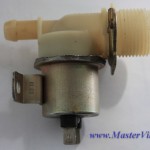 Alteration of the valve from the washing machine to power supply with a voltage of 12 volts DC
Alteration of the valve from the washing machine to power supply with a voltage of 12 volts DC